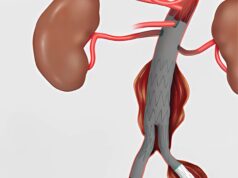There has been a marked reduction in perioperative stroke and death following carotid endarterectomy performed in the recent CREST protocol when compared with older trials, a new analysis presented at the Society for Vascular Surgery Annual Meeting, Boston, USA, has shown. These complication rates, Brajesh K Lal, University of Maryland, Baltimore, USA, told delegates, now provide the new benchmark when comparing alternative therapies in the management of symptomatic and asymptomatic carotid stenosis.
Peri-operative stroke and death rates following carotid endarterectomy in the North American Symptomatic Carotid Endarterectomy Trial (NASCET) and the Asymptomatic Carotid Atherosclerosis Study (ACAS) were the standards to compare results of surgery and carotid artery stenting in subsequent reports.
“These trials recruited patients between 1987 and 1996 and reported their results between 1991 and 1998,” Lal said.
CREST (Carotid revascularisation, endarterectomy vs. stenting trial) recently reported its results comparing endarterectomy vs. stenting. The objective of this analysis was to determine if the perioperative complication rate of endarterectomy has evolved over the past 20 years.
Lal said that CREST was a prospective trial of symptomatic and asymptomatic carotid stenosis patients randomly allocated to endarterectomy or stenting. Lal and colleagues compared the combined rate of peri-operative stroke and death after endarterectomy in CREST with those in the two NASCET reports and in ACAS. They also compared the criteria used to credential surgeons and define peri-operative stroke, along with surgical technique and peri-operative medical therapy. Lal showed delegates details on inclusion criteria, enrolment, endpoints, baseline data, medical therapy information and procedural characteristics.
“The primary endpoint for ACAS and NASCET was based on stroke and death, and in CREST it was based on stroke, myocardial infarction and death. The definition of stroke was consistent across the trials – an acute neurological ischaemic event of at least 24 hours duration with focal signs and symptoms and adjudicated by neurologists blinded to treatment,” Lal explained.
CREST randomised 2,502 patients (1,240 to endarterectomy and 1,262 to stenting); NASCET I, 659 patients (328 to endarterectomy and 331 to medical therapy alone); NASCET II, 858 patients (430 to endarterectomy and 428 to medical therapy); and ACAS enrolled 1,659 patients (825 to endarterectomy and 834 to medical therapy). Table I shows enrolment differences of each randomised controlled trial. Credentialing criteria for surgeons were similar across the trials: A minimum endarterectomy operative experience of 12 cases per year with a perioperative stroke rate of ≤3% (asymptomatics) and ≤5% (symptomatics) in the most recent 50 cases. Combined peri-operative stroke and death rates across these trials are reported in Table II.
Key points presented by Lal:
CREST included patients ≥80 years of age;
Periprocedural stroke and death has not changed dramatically in asymptomatic patients, if angiographic complications are excluded from ACAS results (1.5% vs. 1.4%; ACAS vs. CREST);
Periprocedural stroke and death has reduced dramatically in symptomatic patients (5.8 and 6.7% vs. 3.2%: NASCET vs. CREST);
The CREST cohort had more hypertension, diabetes and dyslipidemiathan ACAS and NASCET;
The CREST cohort underwent more intra-operative shunting and patch angioplasty than ACAS and NASCET;
The CREST cohort had increased use of peri-operative antilipid and antihypertensive therapy.
“The asymptomatic and symptomatic CREST cohorts did very well compared to ACAS and NASCET,” Lal said. Operative stroke and death in asymptomatic patients, he added, was similar to ACAS (after excluding preoperative angiography-related morbidity in ACAS). “Operative stroke and death in symptomatic patients was lower than NASCET and may be related to increased intraoperative shunting and patch angioplasty and perioperative antilipid and antihypertensive therapy,” Lal concluded. “Since these interventions were not utilised universally in the CREST cohort undergoing endarterectomy, there is still room for improvement in these results.” Finally, he emphasised that “CREST has established new periprocedural stroke and death rates for carotid endarterectomy in asymptomatic (1.4%) and symptomatic (3.2%) patients. These must serve as the new benchmarks to compare any new revascularisation procedure”.












